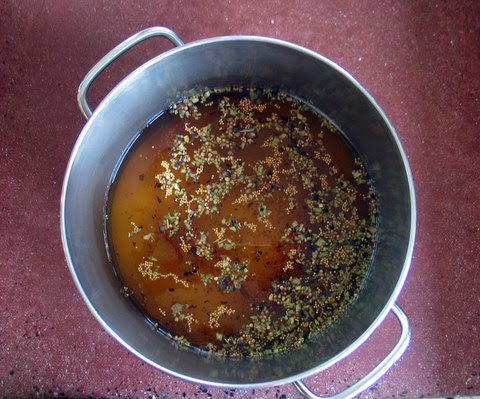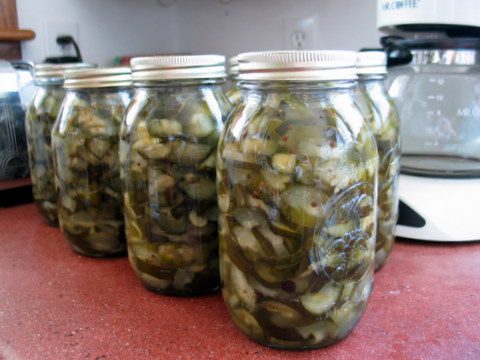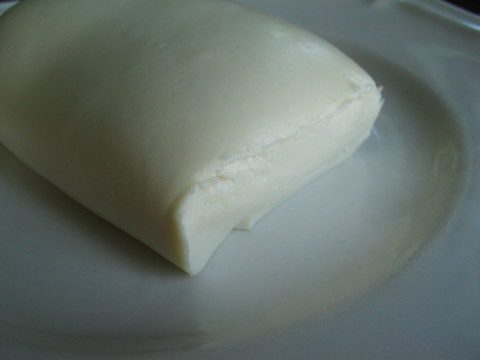Today I invented a new candy: Pickle Spice Taffy.

It was really quite simple. All I did was measure 2 quarts of vinegar, 16 cups of sugar, 1/4 cup of pickling spice, and 1/4 cup of salt, mix them all together in a large stainless steel pot, set the pot on the stove and turn the burner to high, and then go upstairs to put the children down for naps and totally, completely, positively forget about the pot of boiling sugar-vinegar for the next forty-five freakin’ minutes!
Yes, it was an accident. Yes, there is such a thing as vinegar candy (and yes, I’ve made it before), but that recipe does not call for pickling spice, of that I am sure.
I did sample my disaster (cooks are constitutionally unable to not taste things), and it wasn’t too bad (I did about lose a couple of teeth due to the extreme sticky factor), though certainly not a keeper. The compost pile ate that syrupy mess, and now I’m left with a severely bemired kettle.
I need to get cracking on that brine redo (this time no leaving the kitchen while the stove is on)—the cukes are patiently waiting for their sweet-and-sour soaking liquid.

Okay. Now that the brine is heating up (the computer resides in the kitchen, folks—I’m right here), I’ll tell you the correct way to make sweet pickles. I really do know how to make them; this is the second double batch of the season and the first batch proceeded without event (if you don’t count the fact that I used a different kind of cucumber and that after undergoing four days of hot water soaks, the cucumber centers disintegrated into a liquid that sloshed about inside the newly hollow cuke and reminded me of snozzcumbers; though I couldn’t slice them like I do normally and had to settle for a chopped sweet pickle, they tasted just fine).
Sweet Pickles
Adapted from the Mennonite Community Cookbook by Mary Emma Showalter
These are deliciously crisp. We put the slices on grilled cheese sandwiches, or I chop the pickles up and add them to egg, tuna, and chicken salads. The kids adore them.
These pickles take seven days to make, but as you can see from directions below, you are really only doing work on days one, four, and seven.
Sometimes I have trouble with my jars staying sealed for the long-haul, so I tried a trick that my Aunt Valerie shared with me—preheating the jars in a 200 degree oven before adding the hot pickles. We’ll see how it works.
A few notes about the ingredients:
*I usually use Straight Eight Cucumbers, though this year I also planted an heirloom variety called A & C Pickling Cucumber, which I think, considering their disintegrating insides, would make excellent dill pickle spears.
*I use apple cider vinegar.
*I buy pickling spice in bulk, but for those of you who are curious about that sort of thing, it is comprised of black pepper, allspice, bay leaves, cinnamon, and cloves.
7 pounds of pickling cucumbers
8 cups sugar
4 cups vinegar
2 tablespoons salt
2 tablespoons pickling spice
Day One:
Wash the cucumbers. Put them in a container (I use a five-gallon bucket that we keep reserved for food projects) and pour boiling water over them till they are completely covered. Place a pie plate (or some such thing) on top of the cukes to help push them down in the water, and cover the container with a lid of some sort.

Day Two:
Drain the cucumbers and pour fresh boiling water over them.
Day Three:
Drain the cucumbers and pour fresh boiling water over them.
Day Four:
Drain the cucumbers. Cut them into 1/8th inch slices and put the slices back in the bucket from whence they came.
In a large, heavy kettle, combine the sugar, vinegar, salt, and pickling spice. Bring the mixture to a boil, stirring occasionally. Do not leave the room.

When the brine has reached a full rolling boil, pour it over the cucumber slices. Cover the container.

Day Five:
Drain the pickles, reserving the brine. Boil the brine and pour it back over the pickle slices.
Day Six:
Drain pickles, boil brine, and re-cover the pickle slices. (I’m getting tired of repeating myself.)
Day Seven:
Wash your canning jars (half-pints, pints, quarts, whatever you want) and lay them on their sides in the oven. Turn the oven to 200 degrees. Assemble your lids and rings.

Drain the pickles. Bring the brine to a boil. Working in batches (because you don’t want to cook the pickles for too long), add some of the pickle slices.

When the brine has come back to a full boil, scoop the pickles into the jar, tamping them down with a fork. Once the jar is well-packed, ladle in enough brine to cover the pickles, jiggling the jar to release any air bubbles. Wipe the jar rim with a very clean, wet cloth, put the lid on top and screw the ring on tightly. Set the jar (careful—it’s hot!) on a corner of counter where it won’t be bothered for a day.

Repeat the process till you have used up all the pickles. Discard any leftover brine.
Yield: about eight pints.
About One Year Ago: Ups and Downs, including yet another kitchen flop.


5 Comments
Anonymous
I just can't shake this nagging thought that keeps bothering me ever since you posted this recipe, so here goes… 🙂
Your final instruction in the recipe is to discard any leftover brine.
Do you really do that?, the scrounge in me can hardly stand it.
The two best uses I know for that brine (and I'd love to hear of others) is:
1. to thin potato, macaroni or egg salad.
or
2. in bread.
I make 6 loaves at a time and use about 1/2 cup sweet pickle juice as part of the liquid and adjust the sweetener accordingly.
The vinegar in it helps produce nicer bread.
So my parting advice is save that brine or can it separately and use it!
love these pickles!
S-
And my burn story is this. About a week ago, I put jar lids on the stove to heat to can salsa. Forgot I put them on and we (the whole family) went over to Baers for over an hour. When we came back the kitchen was 'blue', the kettle looked fine but later I discovered it warped, the lids were burned black and the rubber was twisted and charred.
All I could think was, thank you Lord our house did not burn down.
Cookie baker Lynn
Oh my gosh, that sounds like something I'd do! You inspire me to try canning again. I haven't in years, aside from freezer jam. But that doesn't count, does it?
Zoë
I burned a pot of rice something awful last week. A half inch of rice all around the edges of the pot charred pitch black. I had gone out into the garden to pull all of my onions. And it would have been even worse had Brad not come home for lunch and walked in the door…because I had at least another 10 minutes of work to do. Oh well, at least I can blame it on pregnancy 🙂
Mama Pea
I boiled a kettle dry just the other day. But I came out better than you did . . . set a pan of water on high to heat up for blanching peas, walked away and completely forgot it. Caught it just as all the water was gone and before disasterous things happened to my pan. Multi-tasking gone awry, huh?
Thanks for the pickle recipe. I'm gonna try it.
Anonymous
I bet the house smelled heavenly seeing that you boiled the brine for so long. My eyes are burning just thinking about it. Your compost pile sure does get it's share of sugar. I'm remembering the peanut brittle last fall.
So you tried the open kettle method after all. You can heat the jars in the oven to 225 degrees. It won't hurt the jars.
Aunt V.